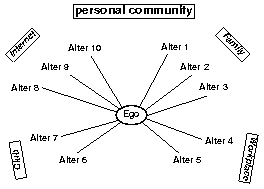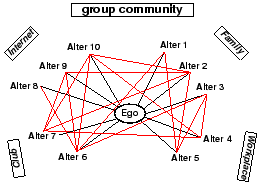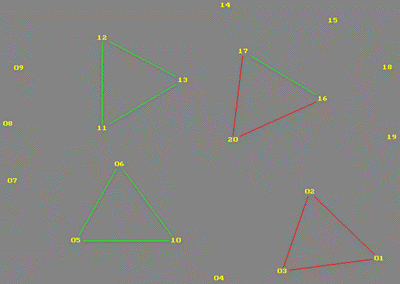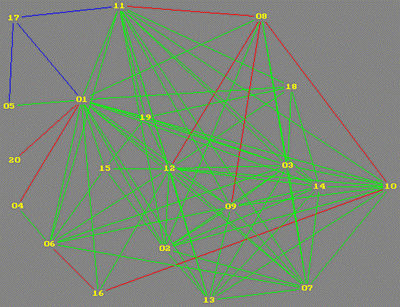Christoph Müller
Institute for Sociology, University of Berne
Contact - Disclaimer - Copyright
In this article, we present an on-going research project about "virtual communities". After an introduction 1 we raise the main research questions and present some theoretical considerations (2). In part 3 we propose basic definitions for "communities". In a 4. part, we describe preliminary results of a personal network study we conducted in summer 1998 with 101 frequent users of chatgroups and newsgroups in Switzerland. After a short discussion (5)we present an outlook for future research (6).
"Virtualisation" can be regarded as a constitutional characteristic of modern "Information Societies", where social relations tend to be more and more maintained by technical means. Internet is becoming a very important medium for this type of interactions and exchanges, which do not require face-to-face contacts. Internet TCP/IP protocols do not only transmit one-way information from a host to a client, but they also serve as a tool for interactive communication and co-operation and offer thus the possibility of establishing 'virtual communities'. Whether or not this really happens is the question of our research.
The project studies the question of whether discussion groups within the communication services of the Internet have an integrative function, exerting a binding force on their members. Under what conditions Internet communication services can be regarded as "communities"?
In the wider context of our research group "Individualisation and Integration" 1, we pursue a question which has accompanied sociology ever since its beginnings: how is social integration possible in the face of growing differentiation and individualisation? So far sociology has primarily paid attention to processes of disintegration. Under the headings of 'differentiation' and 'individualisation', sociology diagnosed a loosening of societal coherence and the corrosion of traditional forms of integration. However, the question of whether new forms of integration emerge that offset those disintegrative tendencies has been posed only rarely.
Internet communication groups like USENET-Newsgroups 2, chatgroups 3 or MUD 4 groups offer for the first time the possibility to establish multilateral relationships that are independent of spatial and (in the case of asynchronous communication services) temporal copresence. In our research, we study the following four central questions:
The theoretical background of our research starts on a critical discussion of the hypothesis of individualisation in contemporary western societies 5: In an "atomised" society, community get "lost" &endash; its members are "bowling alone" (Robert Putnam).
However, empirical studies have shown different results 6. Yet, from the perspective of Social Network Analysis, communities did never get "lost", although they take different forms in contemporary society: A typical "modern" personal community consists of memberships in multiple, interest-based communities, where people maintain "diversified portfolios of ties providing access to a wide range of network members and resources." Wellman, et al. 1988 (p.197). In general, these relationships are functionally more specific, temporary less durable, and geographically dispersed &endash; and therefore often maintained by telecommunication means like the telephone or -- more and more -- the Internet.
This shows a well known ambivalence of technology with different consequences of the same technological settings: On one hand, technologies can be regarded as loosening traditional forms of relationships, and at the same time, social relations are more and more maintained by technical means.
The Internet &endash; as a "technologically open" and socially contested field &endash; is of special interest in this context, because Internet communication services like Newsgroups or Chatgroups offer the possibility of new forms of inter-active communication and co-operation without physical contact and across geographical borders. Whether or not this really happens, is subject of this research.
In mass media as well as in some social science studies, the term "community" is frequently used without a clear definition. Further, definitions are often based on fixed categories like kinship ("communities of blood") or neighbourhood ("communities of place"). In our research, we do not define communities as categorical units, but as empirically discovered relations between different elements of a social network 7. Following the proposition of Wellman and Gulia 1997, we distinguish two basic forms of communities:


On this "network" dimension, we can characterise communities by the density of contacts. Therefore, community is basically considered as being a gradual phenomenon.
On a second dimension, following Tyrell 1985, we situate "groups" between the social categories of interaction and organisation:
Corresponding to this basic distinction, we propose the following three criteria for a "group":
(a) frequent, multilateral and for a certain period durable communication contacts;
(b) commonly shared norms, values and collective practices;
(c) defined boundaries between inside and outside, and development of a common identity.
For the study of "virtual" communities, it is important to note that this definition does not a priori exclude any form of social integration mediated by technical means. It does not require face-to-face contacts, nor formal membership, nor a common physical place or area. That's why we could expect that &endash; in principle &endash; there could be the possibility of strong Internet group communities.
However, as we are studying online virtual communities, we should include &endash; in the strong sense of this term &endash; only those communities which are maintained strictly online.
To what extent communities following these criteria really exist in the Internet?
In order to answer this question, we selected two technically different types of Internet communication services: Newsgroups and Chatgroups. To study these fields, we are applying three different research methods, combining qualitative and quantitative methods:
In most newsgroups as well as in most chat services, messages consist of pure text9. In addition to other typical characteristics of computer mediated communication (CMC), this fact implies some important restrictions compared to face-to-face interaction (for a review and discussion, cf. Walther 1996 ):
These restrictions suggest that virtual relations tend to be unstable, with frequent turnovers. Although a lot of studies show the existence of very lively interactions in computer mediated communications services 11 , these studies do not allow us to answer our main research questions, if communities, as defined above, really exist. While most of these research projects are following an ethnographic approach, we focused our study on the perspective of social networks. This allows us to detect personal communities, group communities, as well as to compare online and offline personal networks of users.
Finally, the network approach allows us to identify the interferences between online and offline networks, analysing in how far online conversation is continued by private e-mail, by telephone, or by face-to-face contact.
In order to know empirically if Internet communities really exist, we organised a survey with offline face-to-face interviews with 100 frequent users of two newsgroups and three chatgroups. Following pragmatic considerations, especially because of the restricted budget, we decided to select only services physically or symbolically located in Switzerland. 12
The network survey provided us with two data sets, one with the data of the 101 Egos, and &endash; because we asked them about their personal networks online and offline &endash; one with data of the 1600 Alteri the Egos mentioned. 13
What kinds of personal networks do these Egos have?
These results demonstrate that Internet users are not "isolated": they do have personal networks. (This result can be confirmed with the notion that only 20% of the Egos live in a one-person household, which is much less than comparable urban population and has a strong correlation with the age of the Egos).
Further, we observe in general a strong overlap of online and offline ties: Only one quarter of the relations between Ego and Alter are exclusively online, another quarter is exclusively offline, and 50% of all relations are both online and offline. For example, every third peer, with whom Ego spend the offline leisure time, is also an Internetpeer.
Online ties are therefore in most cases not uniplex, but multiplex: In general, online and offline relations do not form separate clusters.
In most of the cases, the Egos did not know their Internet peers from an offline context (like family, school, workplace, or clubs) and then also met online &endash; but their first contact was online, and after that they met offline.
We could now assume that the relations between Ego and Internetpeers are just casual or "weak" ties, but considering the facts that...
... those relations are not only "weak" ties.
On the other hand, only about 2% of all "strong" Ego-Alter-relations are exclusively online! We conclude that strong Internet ties do exist, but typically they are stabilised by frequent offline contacts. They are locally "rooted".
We argue that these offline contacts are quite useful, because they help to overcome some deficiencies of CMC: They support the construction and reconstruction of trust and confidence, they allow positive sanctioning of "friendly behaviour", and &endash; after all &endash; we should not forget that especially the chat users in our sample are quite young, living in a age of adolescence, where dating is a very important issue! ( In some communication services, there are regular offline meetings organised by a group of volunteers or even promoted by the Staff.)
A second important result is that almost all items of the statistical analysis show significant differences between the users of Chats and Newsgroups
Analysing the result that &endash; in average &endash; the personal networks of Newsgroup users are smaller than those of chat users, we found a comparable number of offline ties, whereas chat users mentioned significantly more online ties.
Further, the overlap of online- and offline-relations is much stronger in chatgroups than in Newsgroups, where only few users knew their online peers also in an offline context.
This means that personal relations between Newsgroups tend to be uniplex, where chat users mentioned significantly more multiplex relations with their Internetpeers.
I can illustrate this with the following examples of networks graphs:

Graph 1 shows a typical personal network of a Newsgroup user, with different clusters or subgroups, and isolates. The graph is based on a "who knows whom?" matrix: Every respondent answered the questions, if each of his Alteri (Nr. 1, 2, 3, ... (n-1)) do know each other Alteri (Nr. 2, 3, 4,... n) online only (red), offline only (blue), on-and-offline (green) or not at all (blank).
The Ego-Alteri relations are not represented in the following two graphs. Distances do not reflect valued social distances.
Graph 2 shows a typical network of a chat user, with a lot of mutual online and offline ties (represented by green lines).

These illustrations show that the networks of chatgroup users are more densely knit, they have less isolates, and their Alteri often know each other in a offline context as well. We can conclude that both Newsgroup and Chat users do have personal networks, but only chatgroups users have online group communities.
However, as a lot of the chat users in the sample often do have offline contacts with their Alteri as well, these chats can not be considered as virtual communities in the "strong" sense of the definition. Therefore, we argue that, at least in our case study, Internet communication services are nothing completely new. Instead, they have to be regarded as a new medium, or a new channel for interactions, like for example the telephone some decades ago.
Our results contrast with previous ethnographic studies, mostly from the US or Australia, which claimed the existence of "virtual Internet communities" in the strong definition. 14
For the Swiss context, we have to conclude that even if the technical possibilities of Internet communication services like newsgroups or chats do allow strong, exclusively online contacts with geographically dispersed people, this does not actually happens!
I consider this result as an example for the different use of technologies in a different cultural context &endash; and I believe that there are some reasons for these differences:
Our case study illustrates that different cultural backgrounds and different social settings lead to different uses of the same technology. On the other hand different technological settings in Newsgroups or chatgroups correlate with different patterns of use and with different compositions of personal networks.
These two results are both confirming the social shaping approach in the Sociology of Technology (MacKenzie and Wajcman 1985, Bijker and Law 1992 ).
In a next step, I would like to go further in the research of such interferences between technological systems and cultural praxis: How do different technical settings of Internet communication services influence the process of establishing and maintaining "virtual communities"?, and vice versa: How do participants shape technologies by using them?
In studying the "design principles" of Internet communication services, we should be able to find out why some of them function well, while others fail. I order to do so, I am planning to go deeper in analysing the symbolic construction of such groups, paying special attention to the mechanisms of inclusions and exclusions.
footnotes -- references -- biographical note
Back to the "Virtual communities" introduction page.
0) John Armitage and Joanne Roberts (eds.) 1999: exploring cyber society. Social, Political, Economic and Cultural Isues. Proceedings of the conference, 5th-7th. July 1999. University of Northumbria at Newcastle, UK, School of Social, Political and Economic Sciences, 2 Volumes. (back)
1) The research project "Virtual Communities &endash; The Social World of the Internet" is part of the research group "Individualisation and Integration" of the social science Priority Programme "Switzerland: Towards the Future". The project is directed by Prof. Dr. Bettina Heintz (University of Mainz). Grants are provided by the Swiss National Science Foundation. The project is hosted by the Institute for Sociology of the University of Berne: http://www.soz.unibe.ch --> new link: www.socio5.ch -- (back)
2) Newsgroups are public bulletin boards, where every user can "post" a message (e.g., an information or a question). Formally, these messages look like e-mail messages, but &endash; as they are public &endash; they are not going out to just one person, but to an unknown number of people. After posting a message, users probably get a public reply to their posting. Sometimes, this leads to "threads" of discussion. Newsgroup messages are spread almost worldwide to other Newsgroup-Servers. Presently, there are several 10'000 of different newsgroups. Some of them have a lot of traffic, and some are more quiet or even "dead". Newsgroups are symbolically organised by nations and subjects, for example computer questions. Other groups concentrate on "recreational" topics, like diving or snowboarding, or on scientific questions. (back)
3) Unlike the asynchronous Newsgroups, chatgroups allow you to communicate and to get feedback almost in "real time". To participate, you log in to a Internet server, identifying yourself with a name. This name could be your legal name, but in most cases, it is a fictional nickname. In some chats, you can use more than one nicknames yourself, playing with thus with different "figures", or change your nickname whenever you want. (back)
4) MUDs stands for "Multi User Dungeons" or "Multi User Dimensions", a textual multi-participant virtual place. Like in chat services, users can synchronously communicate with other users connected at the same time. Unlike in chat services, MUD users can also move through different "rooms", and they can construct virtual "objects". (back)
5) Especially in German sociology, there is a remarkable tradition of theories stating a "loss of community" in the traditional form of families, neighbourhoods, or professional groups (from Ferdinand Tönnies' "Gemeinschaft und Gesellschaft" and Georg Simmel to Beck/Beck-Gernsheim 1994 and Heitmeyer 1997b ). For the UK, see for example Anthony Giddens. In the USA, the 'community question' is often discussed under the label of 'communitarian' critique of modern societies (Etzioni 1988, Bellah 1985 et al.). (back)
6) Fischer, et al. 1977, Wellman 1979 . For a general overview, cf. the introduction of Wellman 1998. (back)
7) For a general overview of "Social Network Analysis", cf. Scott 1991, Knoke and Kuklinksi 1982, Wellman and Berkowitz 1988, updated 1997. (back)
8) In this sense, Internet communication services can be regarded as a special form of "imagined communities" ( Anderson 1983 , Calhoun 1992 ). They permanently have to be constructed and reconstructed by symbolic means. However, and unlike nations or the "imagined community" of all Internet users, participants of online communications groups do have regular contacts with participants. They thus maintain their "social worlds" by regular interaction. (back)
9) There are other chat forms including face-to-face contact, (e.g., "CU-SeeMe"), or systems supporting "Avatars" or even 3D representations of fictional rooms. Further, there are advances in Internet-based telephony. In Newsgroups, one can also exchange pictures, videos or audio files. However, the vast majority of Internet communication services is still restricted to text-only forms of interaction, mainly because of technical reasons (i.e. the restricted bandwith). For the research presented here, we studied only text-based services. (back)
10) Cf. Turkle 1996 , and &endash; especially for gender-switching &endash; Bruckman 1993 . For a general approach to role playing in society cf. the work of Ervin Goffman. (back)
11) For example, Reid 1991 studied an IRC group, Smith 1996 analysed the famous forum "The Well", Baym 1995 presented a Usenet Newsgroup, Curtis 1992 observed a MUD group. (back)
12) The observed newsgroups are >ch.comp<, discussing computer issues, >ch.talk< with debates about general topics of Swiss society of politics. The chat services are >SWIX<, >sfdrs< and >ezinfo<, without specific topics. In principle, all these services are public in the sense that all Internet users can have access, but in fact they are used mostly by Swiss people, and the messages are written mostly in German or even Swiss german. There are other services in the French and Italian part of Switzerland which still have to be studied. (back)
13) We are aware of some serious difficulties in sampling Internet users. From the statistician's point of view, there are two main problems in sampling a specific Internet population: (1) As there is no formal membership for the users of the services we analysed, and as we do not precisely know the exact number of all Internet users, we are not able define the basic population "N" of the sample, which is a prerequisite for the usual statistical calculations. (2) Furthermore, the identity of each user is ambiguous: Participants may use a nickname, they may continuously change their names, they may even use more than one name at the same time. Even if we would be able to identify every Internet account, we would not know for sure, how many different persons are using this account or a given (nick)name, or how many "personae" (figures) are played by one and the same person. Therefore, our results are referring to the "personae", and not to the persons, and our results are not representative for all users of a given service. (back)
14) E.g., Aoki 1994, Baym 1995, Beamish 1995, Bruckman 1993, Curtis 1992, Reid 1991, Smith 1996, Turkle 1996, Watson 1997. (back)
15) This can be regarded as a special aspect of the "critical mass" issue in organisation research: On one hand, the relatively small number of participants of the same language with similar interests faces problems of building efficient exchange communities, on the other hand, a smaller organisation facilitate the overview of its participants. (back)
footnotes -- references -- biographical note
Back to the "Virtual communities" introduction page.
(Note: As I am not able to revise all the links, some of them may be out of date. I am sorry for this.)
Anderson, Ben 1983: Imagined Communities: Reflections of the Origin and Spread of Nationalism. London (New Left Books).
Aoki, Kumiko 1994: "Virtual Communities in Japan" http://www.uni-koeln.de/themen/cmc/text/aoki.94.txt.
Baym, Nancy K. 1995: "The Emergence of Community in Computer-Mediated Communication". In CyberSociety: Computer-mediated Communication and Community, edited by Steven G. Jones. London etc. (Sage): 138-163.
Beamish, Anne 1995: "Communities on-line: A Study of community-based Computer Networks." http://sap.mit.edu/anneb/cn-thesis/.
Beck, Ulrich, and Elisabeth Beck-Gernsheim, eds. 1994: Riskante Freiheiten. FfM (Suhrkamp).
Bellah, Robert et al. 1985: Habits of the Heart. Berkeley.
Bijker, Wiebe E., and John Law, eds. 1992: Shaping Technology / Building Society. Studies in Sociotechnical Change. Cambridge/London (MIT Press).
Bruckman, Amy 1993: "Gender Swapping on the Internet" http://www.cpsr.org/cpsr/gender/gender-swapping.ps.Z or ftp://ftp.cc.gatech.edu/pub/people/asb/papers/gender-swapping.txt.
Calhoun, Craig 1992: "Indirect Relationships and Imagined Communities: Large-Scale Social Integration and the Transformation of Everyday Life". In Social Theory for a Changing Society, edited by Pierre Bourdieu and James S. Coleman. Boulder (Westview Press): 95-130.
Curtis, Pavel 1992: "Mudding: Social Phenomena in Text-Based Virtual Realities" ftp://ftp.lambda.moo.mud.org/pub/MOO/papers/DIAC92.txt.
Etzioni, Amitai 1988: The Moral Dimension. New York (The Free Press).
Fischer, Claude S., Robert Max Jackson, C. Ann Stueve, Kathleen Gerson, and Lynne Mc Callister Jones 1977: Networks and Places, Social Relations in Urban Settings. New York (Free Press).
Heitmeyer, Wilhelm, ed. 1997b: Was hält die Gesellschaft zusammen? FfM (Suhrkamp).
Knoke, David, and James H. Kuklinksi 1982: Network Analysis. London etc. (Sage).
MacKenzie, Donald, and Judy Wajcman, eds. 1985: The Social Shaping of Technology. Milton Keynes (Open University Press).
MacKinnon, Richard C. 1997: "Punishing the Persona: Correctional Strategies for the Virtual Offender". In Virtual Culture. Identity & Communication in Cybersociety, edited by Steven G. Jones. London etc. (Sage): 206-235.
Reid, Elisabeth 1991: "Electropolis. Communication and Community on Internet Relay Chat" ftp://ftp.lambda.moo.mud.org/pub/MOO/papers/electropolis.txt or http://people.we.mediaone.net/elizrs/electropolis.txt.
Scott, John 1991: Social Network Analysis. A Handbook. London: (Sage).
Smith, Marc A. 1996: "Voices from the WELL: The Logics of the Virtual Commons" http://infosoc.uni-koeln.de/etext/text/smith.n01.txt.
Turkle, Sherry 1996: Life on the Screen. Identity in the Age of the Internet. London: (Phoenix).
Tyrell, Hartmann 1985: "Zwischen Interaktion und Organisation I. Gruppe als Systemtyp". In Gruppensoziologie, edited by Friedhelm Neidhard. Köln (KZfSS): 75-87.
Walther, Joseph B. 1996: "Computer-Mediated Communication: Impersonal, Interpersonal, and Hyperpersonal Interaction" Communication Research (23) 1, Feb. 1996: 3-43.
Watson, Nessim 1997: "Why We Argue About Virtual Community: A Case Study of the Phish.Net Fan Community". In Virtual Culture. Identity & Communication in Cybersociety, edited by Steven G. Jones. London etc. (Sage): 102-132.
Wellman, Barry 1979: "The Community Question. The Intimate Networks of East Yorkers" American Journal of Sociology (84) march: 1201-1231.
Wellman, Barry, ed. 1998: Networks in the Global Village. Boulder, CO (Westwood).
Wellman, Barry, and S.D. Berkowitz, eds. 1988: Social Structures: A Network Approach. Cambridge (Cambridge UP).
Wellman, Barry, Peter J. Carrington, and Alan Hall 1988: "Networks as Personal Communities". In Social Structures: a Network Approach, edited by Barry Wellman and S.D. Berkowitz. Cambridge (Cambridge University Press): 130 - 184.
Wellman, Barry, and Milena Gulia 1997: "Net Surfers don't Ride alone: Virtual Communities as Communities". In Communities in Cyberspace, edited by Marc A. Smith and Peter Kollock. London (Routledge).
Christoph Müller (*1964) finished his studies in Sociology at the University of Zürich in 1995 and is now working on a research project on "Internet Online Communities", as well as on a PhD thesis in Sociology at the University of Berne/Switzerland. Research grants have been provided by the Swiss National Foundation.
--> Hauptseite --> page d'introduction --> main page
www.socio5.ch © produced: 14.7.99 -- updated: 8.2.2004 © Christoph Müller Kontakt / Contact / Disclaimer